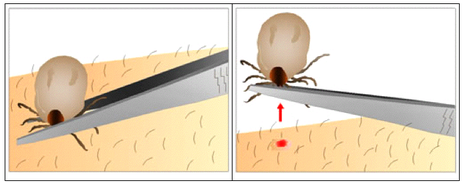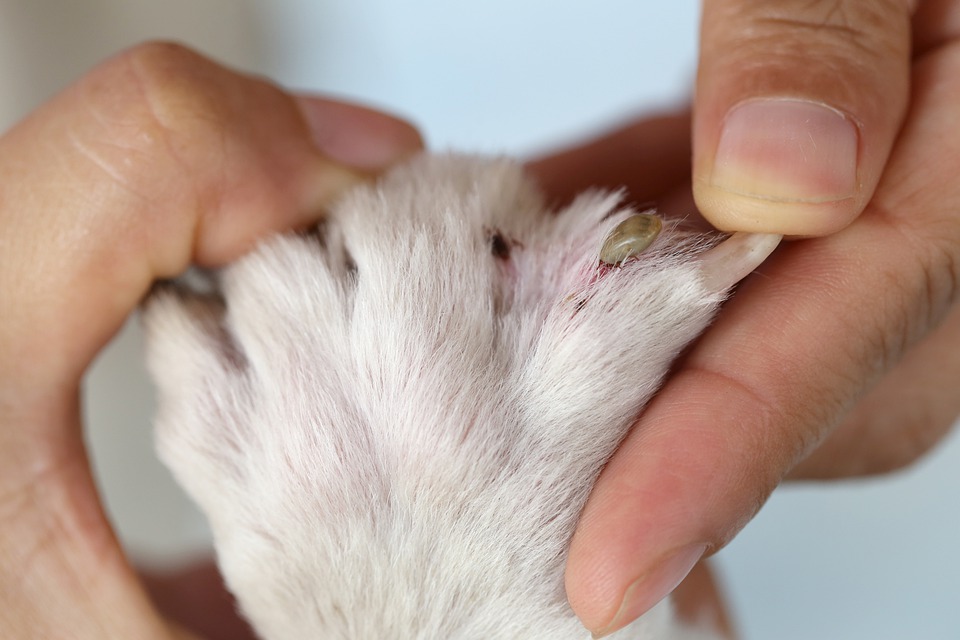Babesiosis, Lyme disease, anaplasmosis, hepatozoonosis, rocky mountain fever… these are some of the unpleasant illnesses transmitted by ticks. If left untreated, tick-borne diseases can become fatal.
So, how can you protect your canine friend from these ugly and dangerous creatures?
Well, for starters, use safe tick-prevention strategies to repel ticks from your dog’s body. These include the use of apple cider vinegar and garlic, which can be included in his diet to make his blood less appealing to ticks.
You can also buy a good tick repellent and spray his body with it.
Unfortunately, some of the remedies don’t offer 100% protection for your dog. In this case, you will need to learn how to safely remove ticks from your dog as soon as you see them.
There are a number of ways to do this but let’s focus on removing ticks using Vaseline.
What You’ll Need
- A tick removal tool or pointed tweezers
CDC recommends using fine-tipped tweezers or tick removal tools that can allow you to grasp the ticks as close to your dog’s skin as possible.
Check this post for the best tools: 12 Best Tick Removal Tools for Dogs
- Vaseline
- Latex gloves
- Soap
- Water
Steps to Follow
Step 1:
Put on your latex gloves. Although rare, some tick infestations can be transmitted to humans. For instance, in case of a scratch, you could become infected.
Step 2:
Look for all the ticks embedded in your dog’s skin. This is a bit straightforward because the bite area will appear swollen.
Check everywhere including the ears.
Ticks are very small and can hide practically everywhere. This is especially true if you have a thick-haired mutt such as a Yorkie, Lhasa Apso, Afghan Hound, or Shih Tzu.
Step 3:
Apply a generous amount of Vaseline on the tick.
The idea here is to make the tick back out or remove its grip from your dog’s skin. This way, the removal becomes easy.
Step 4:
Once the tick is suffocated, use the tick removal tool or tweezers to pull it off. This step is quite tricky because if you are not careful, you can rip the tick and pour its fluids right into your dog’s bloodstream.
For the best results, grasp the tick at the specific point where it meets the dog’s skin (see the image below). Don’t go for the body as it could squish and pour toxins into the dog.
If you grip too high, you will likely leave the tick’s mouthparts in the skin. These can develop into a tick granuloma that will need antibiotics or surgery to get rid of.
After grasping the tick, pull it backward slowly. Don’t attempt to twist it in a clockwise or anti-clockwise motion as this might squash the tick as well.

Step 5:
Once the entire tick is out, apply some Vaseline to suffocate it some more.
Step 6:
Clean the affected area with soap and water then wash your hands as thoroughly as possible.
If possible, disinfect the area with an antibiotic ointment like Polysporin, povidine iodine solution or chlorhexidine.
Although no prescription is required to get the ointments, remember to dilute them to lower their concentration.
You will always find dilution instructions on their labels.
Alternatively, consult your vet for more professional input.
Disclaimer:
Generally, suffocating tick with Vaseline is not highly recommended because it is not very effective.
It can actually induce the tick to regurgitate or drool into your dog’s skin or bloodstream, causing infections/diseases.
Covering the tick with Vaseline may also cause the tick to be more slippery and difficult to grasp.
A good ‘home remedy’ alternative is to use alcohol. Check these posts for more insights:
Pro Tips
1. Feel Free To Use Tick Removal Tool Alternatives
If you don’t have a tick removal tool, go ahead and use a credit card, butter knife, or guitar pick to push the tick around until it backs out.
This needs to be done carefully and gently to avoid upsetting the tick in the first place.
The goal is to keep the tick happy for as long as possible so that it doesn’t spit its toxins on your furry friend.
2. Don’t Kill the Tick Right Away
If you care to know if the tick carries disease, don’t kill it right away.
Keep it in a sealed container alongside a piece of grass and send it to your vet for testing.
3. If the Tick’s Mouthparts Are Left Behind…
What many people perceive to be the tick’s “head” is actually not the head but mouthparts or tick jaws (to be precise). The mouthparts carry harpoon-like barbs that attach to its host, allowing it to feed.
If you have a botched job (i.e if the tick’s mouthparts are left behind), attempt to remove them with clean tweezers, but if they can’t come out easily, don’t fret; just leave it and allow your dog’s skin to heal.
According to the CDC, they are not as infectious as an actual tick.
Over time, your pooch’s body will reject and eliminate them.
Nevertheless, keep a close eye on the bite area for a week or so.
Watch out for things like a rash, redness, and swelling as these could indicate an infection.
4. Strive to Remove the Tick Safely
Finally, don’t resort to removing the tick by using dangerous means such as burning it with a cigarette, attaching cotton on it and pulling, and using your fingernails to pick it.
All these only distress the tick and can cause serious consequences.
Final Thoughts
Ticks may be small and seemingly innocent but they carry deadly diseases that can be fatal to dogs.
Therefore, it makes sense to do all you can to safely remove a tick from your dog before it does harm to its host.
The more you wait to remove it from your dog, the higher the chance of disease transmission.
Don’t take any chances. Use prevention strategies to keep them off your dog’s skin.
In addition, check your pet as often as you can and store the necessary tools to deal with these critters right away.
Other Tick Control Guides
Curious about other tick control measures and tools? Feel free to check other our comprehensive guides to help you deal with these pesky critters:
5 Best Tick Sprays for Yard (Safe for Pets)
10 Best Tick Shampoo for Dogs
How to Tell How Long a Tick Has Been Attached To a Dog
Image source: dogheirs
As an Amazon Associate, we may receive a small commission from qualifying purchases but at no extra cost to you. Learn more. Amazon and the Amazon logo are trademarks of Amazon.com, Inc, or its affiliates.

